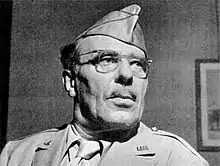Lucien Labaudt | |
|---|---|
 Life artist-correspondent Lucien Lambaudt (December 1943) | |
| Born | Lucien Adolphe Labaudt[1] May 14, 1880[2] Paris, France |
| Died | December 12, 1943 (aged 63) Assam, India |
| Occupation(s) | Painter, educator, muralist, artist-news correspondent |
.jpg.webp)
Lucien Adolphe Labaudt (May 14, 1880 – December 12, 1943) was a French-born American painter based in San Francisco, California.[3] His best-known work may be Powell Street (1934), a mural in fresco at Coit Tower that he created for the Public Works of Art Project.[4]
Biography
Labaudt was born in Paris on May 14, 1880.[3] In 1906, he emigrated to the United States and first settled in Nashville, Tennessee. In 1910, he moved to San Francisco in a studio. In 1919, Labaudt started teaching at the California School of Fine Arts.[2] One of his students was painter Nell Sinton.[5]
He painted two murals in the lobby of the Spring Street Courthouse in Los Angeles: Life on the Old Spanish and American Ranchos in 1938 and Aerodynamism in 1941.[6]
Labaudt was one of a select number of civilian artists invited to join the United States Army Art Program in World War II. He was appointed to the program in April 1943, and assigned to the China Burma India Theater. When the Army's War Art Unit was abruptly eliminated by Congress, he joined the war art program of Life magazine. He left Los Angeles for India in September 1943, traveling for two months aboard a Liberty ship carrying a cargo of dynamite.[7] He was killed in a plane crash in Assam on December 12, 1943, en route to China, where he had been assigned to capture scenes of guerrilla warfare. Labaudt was the first war correspondent killed in that theatre[8] and the only Life artist-correspondent to die in the war. None of his sketches or personal effects survived.[4][9][2][10]
Legacy
A Liberty ship named the SS Lucien Labaudt was christened at Richmond Shipyards on April 7, 1944.[11]
In 1946, Labaudt's widow Marcelle opened the Lucien Labaudt Art Gallery at 1407 Gough Street in San Francisco.[12][11] His work can be seen at the San Francisco Museum of Modern Art.[13]
References
- ↑ "Labaudt, Lucien Adolphe". Getty Museum. Retrieved 4 May 2021.
- 1 2 3 "Lucien Labaudt (1880-1943)". George Stern Fine Arts. Retrieved 4 May 2021.
- 1 2 "Artist Lucien Labaudt Loses Life In Plane Crash Near Burma Border". Los Angeles Evening Citizen News. December 15, 1943. p. 1. Retrieved May 4, 2021 – via Newspapers.com.
- 1 2 Sheets, Millard (January 3, 1944). "Letters to the Editor". Life. p. 2. Retrieved November 1, 2022.
- ↑ Heller, Jules; Heller, Nancy G. (2013-12-19). North American Women Artists of the Twentieth Century: A Biographical Dictionary. Routledge. pp. 1692–1693. ISBN 978-1-135-63889-4.
- ↑ "U.S. Courthouse, Western Division: Labaudt Murals – Los Angeles CA". The Living New Deal. Department of Geography, University of California, Berkeley. Retrieved May 4, 2021.
- ↑ "Lucien Labaudt Exhibition". Oakland Tribune. October 15, 1944. p. 22.
- ↑ "U.S. Artist is Killed in India Plane Crash". The New York Times. December 16, 1943. Retrieved November 2, 2022.
- ↑ "Why Send Artists into Combat?". They Drew Fire: Combat Artists of World War II. PBS. Retrieved November 1, 2022.
- ↑ "Nine Artists Who Lost Their Lives on the Battlefield". History Net. 24 March 2020. Retrieved 4 May 2021.
- 1 2 Fuller, Mary (August 1962). "Lucien Labaudt: In Memorium". Artforum. pp. 24–25. Retrieved November 1, 2022.
- ↑ "Lucien and Marcelle Labaudt papers, 1896–1987". Archives of American Art. Smithsonian. Retrieved May 4, 2021.
- ↑ "Lucien Labaudt". SFMOMA. Retrieved May 4, 2021.
External links
- Lucien Labaudt at The Living New Deal
- Lucien Labaudt | http://digitalassets.lib.berkeley.edu/cara/ucb/text/Cara_Volume_19.pdf
- Lucien Labaudt L'Atelier, oil on canvas ,1931, in the OMCA collections | http://collections.museumca.org/?q=collection-item/a8221
- Lucien Labaudt Couch, mahogany furniture, 1930, in the OMCA collections | http://collections.museumca.org/?q=collection-item/a8721